Text
Turning Relationship Arcs into Plots, Part 2: Progress & Setbacks, Costs, and Turning Points
Developing a relationship plotline requires more than the relationship itself. It requires more than a relationship arc. It needs the proper elements of plot in place, otherwise it's not really a relationship plot.
Whether the relationship plot in your story is about love interests, friends, coworkers, mentor and mentee, rivals, or even enemies, and whether it's the A Story, B Story, C Story, or even D Story, it needs to have the proper pieces to be a real Story.
The primary principles of plot are goal, antagonist, conflict, and consequences. Last time, I covered how to apply these to relationships.

The relationship goal will be one of three things: draw closer and/or get along with this person, push away and/or cause dysfunction with this person, or maintain the relationship as is.
The antagonistic force will be what is in the way of the goal. If the character wants to draw closer to the other person, the antagonist pushes them away. If the character wants to be apart from this person, the antagonist pushes them together. If the character wants to maintain the relationship as is, the antagonist is what's disrupting "normal." In some cases, the other character in the relationship is the antagonist.
With the goal and the antagonistic force, the relationship plotline will have conflict. How the characters choose to address the conflict will usually create the arc.
And the conflicts only matter in that they have consequences. What do these characters have to gain or lose in being close? Or in being distant? Often the relationship consequences will affect other plotlines, or vice versa.
Today we will continue talking about relationship plot elements, by covering the secondary principles of plot: progress, setbacks, costs, and turning points.
For a more in-depth explanation of these elements in general, check out my article on the secondary principles of plot.
Below, we will apply these elements to relationship plots.
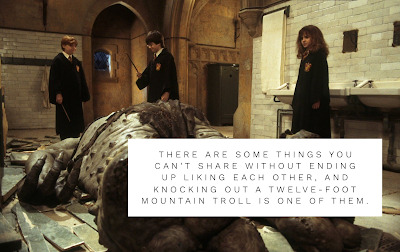
Progress & Setbacks in Relationship Plots
Once upon a time, I was reading a very popular series, and when I got to the last book, the central relationship started driving me crazy. Every time the heroine was with her boyfriend they argued and argued and argued, but it didn't feel like they weregetting anywhere. Their situation was, more or less, the same as it had been from the first argument.This created a circling sensation, which I've talked about before. It happens when a plotline isn't really progressing in one direction or the other (experiencing setbacks).I got to the point where I wished they would just break up. At least then things would be changing and evolving (or devolving).
In short, the relationship plotline wasn't experiencing any real progress or new setbacks. It was just hitting the same conflict over and over. If this has happened to you, don't fret--I've had the exact same problem in one of my manuscripts. Unless you write romance, most of us haven't been taught how to actually write a relationship plotline. And not knowing how to move a plotline forward is exactly what creates this circling sensation.
Remember what I've said in the past: Conflict without consequences is just cleverly disguised filler.
Just as with other plotlines, the relationship plotline needs to be changing, at least a little. As the characters are facing conflicts, they should either begrowing closer or apart. And as with any plotline, there should be some of both (progress and setbacks).
Harry Potter and the Sorcerer's Stone has a great, simple example of this that stands out. Neither of the boys really likes Hermione at first, and Ron outright dislikes her. But the conflict of the mountain troll, and Hermione taking the blame after, cements the trio together. As Rowling simply writes: "There are some things you can't share without ending up liking each other, and knocking out a twelve-foot mountain troll is one of them." Because of the conflict and what happens after, the characters grow closer together.
But anyone who has read the series knows they also experience a lot of setbacks--whether that's Ron and Hermione, Harry and Ron, or Harry and Hermione. At one point or another, each pair thought their relationship might be over.
What "progress" and "setbacks" look like in your relationship plotline will depend upon the goal, relationship type, and plotline itself. For most stories, though, ultimately drawing closer together appears as progress and being pushed apart is seen as a setback. Yet in a negative arc where the characters are genuinely trying to get away from each other, growing apart may be seen as progress, while being forced together appears as a setback.
Because what each character wants in the relationship can change, this can get complex. For example, if Ron doesn't want to be in a relationship with Hermione, isn't the mountain troll incident a setback? But it's the conflict itself that changes his want. Keep in mind: Every conflict has the chance to alter the goal. So it could be that one character decides from the conflict, that he now wants to be close to the other (or, alternatively, apart from her). If the antagonistic force is formidable enough, it will test the character's commitment to the relationship goal--in some cases the character will stay steadfast to the original goal, and in others, he will change that goal(like Ron does).
It's also worthwhile to point out that the audience may have a different point of view. In an enemies-to-lovers romance, the audience will see the enemies drawing closer together as progress, even when the enemies don't want to.
And if this is enough to make your head spin, let me simplify: The point is the conflicts and consequences are creating an ebb and flow of some kind, a zig-zag, through the story. We are going one direction. Then the opposite. Back and forth.
In contrast, circling isn't a zig-zag. It's repetitious, stagnant, and/or vague. The audience isn't sure what direction the relationship is going (or what the point is). Or worse, they don't discern the relationship going in any direction.
The zig-zag can even appear in unusual ways, with The Prestige being our ongoing atypical example. Because the negative steadfast relationship arc is also the A Story, and the participants in the relationship are opponents for each other, the ebb and flow manifest in whether or not one successfully outdoes the other. Sometimes Angier wins, and sometimes Borden wins. But it's a back-and-forth dance. It's a zig-zag.
We'll talk more about this zig-zag and dance in the future whenstructuring the relationship plotline.

Costs in Relationship Plots
Costs are what the character has to "pay" to move forward on the journey toward the goal. This may be physical and mental well-being, time, money, resources, or what have you. The most effective costs come out of the conflicts and consequences of the plot (as opposed to being random bad luck). This reinforces character agency and responsibility, which makes these costs more meaningful (and painful). (Read more about that here.)
While costs are important in any plotline, they can be particularly important in a relationship plotline. If a relationship has no costs, the characters didn't really have to struggle and sacrifice to be together (or, alternatively, apart), and it's the struggle and sacrifice that leads to a powerful relationship arc. The relationship isn't deep, meaningful, or personal without that. It's just surface-level. And the more difficult the journey, the sweeter the triumph.
Generally speaking anyway. (Yes, as I always say, there are always exceptions.)
In any case, we don't want this journey--this relationship--to be built on nothing. Only by showing costs and sacrifices do we truly convey what this relationshipmeansto the character. Pain-free relationships are easy. Pain-full? That is the refiner's fire.
So, what is the cost of the relationship in your story? What do these characters have to "pay"? What are they willing to sacrifice?
In many romances, this is nothing short of everything. The heroine may give up her career, her home, and her old life to be with the person she loves. But this can be true of non-romantic relationships as well. Sam is willing to risk drowning to be near Frodo. Sulley is willing to risk his career--which has meant everything to him--for Boo. Angier is willing to "kill himself" a hundred times to exact revenge on Borden.
Depending on the story you are writing, this may not be the case.
As I pointed out before, Katniss will not bend or accept Gale's worldview that innocent people are worth sacrificing for your own victory--that's the anti-theme of the whole series, so how could she? In some sense, to accept that is to ruin the theme and whole point. In this case, sacrificing the relationship is the cost of maintaining her own internal journey, her own character arc.
As the plotline progresses, the costs should become greater. The steeper and more personal, the more intense.
This is one of the reasons why I'm such a big Mulder and Scully fan. Their journeycosts so much. Ironically, the characters never really have a true, typical "love confession," where they confess how deeply and irrevocably they love each other. But they don't need to. Because they show it. It's in the accumulation of costs. They risk careers, personal lives, safety. They lose loved ones. And surrender whole future trajectories, even very personal dreams. By the end of the original run, they've sacrificed just about everything to the X-Files and each other. They have something so much deeper than words or chemistry. They have years of action. They have proof.
Don't skimp out on costs. The most well-written dialogue, emotional responses, and physical descriptions will mean little to nothing if there is no proof--no action--behind them. Don't only say it. Show it.
* Just want to note that while not having the typical "love confession" trope worked for The X-Files, I'm NOT necessarily saying you should do the same thing. Depending on your story, genre, and relationship plotline, leaving that out could be a big no-no, making the reader feel cheated and frustrated. Always use good judgment. (And in fact, some criticize The X-Files for never really relieving the sexual tension on screen.)

Turning Points in Relationship Plots
I've said this a lot on my blog, but just in case you are new around here, I'll say it again:
A turning point works by (you guessed it) turning the direction of the plot.
This can only happen one of two ways (well, or both of them): a revelation, or an action.
These are the only two ways to turn a plot.
Another way to look at them though, is . . .
Revelation = Information
Action = Event
Sometimes that is more helpful.
In a relationship plotline, think of this as a "Point of No Return."
Let me explain.
At the most basic level, the character is either growing closer to this other person, or apart. (And if they want to maintain, something will disrupt that, so they will still be either drawing closer or further apart to try to get back to "normal.")
In a relationship, a turning point happens when it becomes impossible for the relationship to truly go back to what it was previously. The characters maytry to go back, but it's never really the same. You can't undo a reveal. You can't undo an action.
For example, in Pride and Prejudice, Mr. Darcy shares he's in love with Elizabeth and proposes to her. This is both a revelation and an action that can't be undone. It's a moment where Mr. Darcy moves closer to Elizabeth. In response, Elizabeth creates distance. She will never see Mr. Darcy the same way. Their relationship will never truly go back to what it was. It has become more personal.
Harry and Ron rescuing Hermione from the troll and then Hermione taking the blame? It's a turning point that draws them together. "There are some things you can't share without ending up liking each other."
Scully approaching Mulder as she's struggling with infertility to ask if he'll be the donor for in-vitro? Whew! You don't come back from that one.
Let's go negative.
Palpatine saying that Obi-Wan Kenobi will need to be killed, and Anakin accepting? I think their brotherly love is on its way out. . . .
Gale being somewhat responsible for Prim's death? Goodbye Gale.
Angier sabotaging Borden's magic trick so that his fingers get shot off? Time to exact revenge.
Most relationship plotlines will actually have both positive and negative turning points--this is what helps create the zig-zag effect I talked about above. One turning point draws them closer together, and later, another one pushes them apart. Or however you like to look at the zig-zag for your story. For example, Hermione's tattle-telling on the boys pushes them apart, but then her taking the blame for the troll incident draws them together. We want both progress and setbacks.
Because the other plotlines can affect the relationship plotline, it gets a little more complicated than that, but I'll explain that more in a future post.
Relationship Turning Points: Vulnerability and Reaction
The turning point usually includes a moment of vulnerability. Mr. Darcy is being vulnerable by proposing to Elizabeth. Hermione opens herself up to punishment by covering for the boys. Scully has to risk the awkwardness or pain that might come if Mulder rejects her plea. Saying Obi-wan needs to die puts Obi-wan at more risk. And Gale has to tearfully apologize to the woman he loves.
Notice, too, that the reaction to the vulnerability moves the direction of the relationship. Elizabeth pushes Darcy away. Harry and Ron are shocked, pleased, and accepting of Hermione's sacrifice. Mulder agrees to Scully's offer (I mean, can you get much closer than being a possible baby daddy?). Anakin concedes Obi-wan must die. And Katniss rejects Gale.
When it comes to thrillers, Shawn Coyne talks about an obligatory scene called "Hero at the Mercy of the Villain." I think you know what it entails based on its name. While not the exact same thing, I like to think of the vulnerable moments in relationship plotlines as"Character A at the Mercy of Character B."
The moment works like this:
Action or Revelation --> Character A's Vulnerability --> Accepted or Rejected (or, Neglected) by Character B.
Because of an action(event) or revelation(information), Character A has a vulnerable moment. Character B gets to decide to accept it, reject it, or in some cases, neglect it (that last one isn't usually as powerful--I also think you can argue it's still a form of rejection, but I decided to mention it since it is a little different). That (often) creates the relationship turning point.
Let's look:
Mr. Darcy realizes he's in love with Elizabeth and consequently wants to marry her --> Sharing this, he proposes --> Elizabeth turns him down and pushes him away (rejected).
Scully learns she might have an opportunity to be a mom, but she needs a donor --> She asks Mulder to help --> Mulder agrees, drawing them closer (accepted).
If you want to get super technical, you can view these as two smaller turning points--one from each character: Character A becoming vulnerable because of an action or revelation is the first turning point; it puts the relationship in a crisis. Character B accepting or rejecting it will be rendered in an action(event) or revelation(info), creating the second turning point.
Generally speaking anyway. There are exceptions and variations.
For example, at one point in Monsters Inc., Sulley scares a fake child for a simulation, and Boo has the revelation that he's a scary monster. Her fear makes her vulnerable. Sulley responds by trying to draw closer, but Boo doesn't want to be around him and pushes him away--she's scared of him. In this situation, the vulnerable person is doing the pushing. That can happen, particularly if the characters want different things (one wants to be close and the other wants to be apart).
So, don't get so technical that you never allow room for exceptions and variations. The turning point is meant to turn the relationship--that'sthe main function.
We talk about rules of thumb in order to lay a foundation to allow us to see and understand what's common, as well as what's a variation.
Also, just as a note"Character A" and "Character B" can be either character in the relationship. Sometimes Scully is the vulnerable one, and other times Mulder is. For most relationships, each will have vulnerable moments.
However, that may not be appropriate for all relationships, and so it may lean one direction. Boo, a toddler, is going to be more vulnerable and need more help from Sulley, than Sulley is going to be vulnerable and need Boo's help. And the turning points with her are more likely to function a little differently, because she's so young, naive, and oblivious.
Voluntary Vulnerability vs. Forced Vulnerability
In my earlier examples, Mr. Darcy and Scully are willingly vulnerable in front of Elizabeth and Mulder. They chose to put themselves on the line.
But vulnerable moments can be forced upon Character A, by external forces, other people, or even Character B.
Frodo didn't want to be attacked by a giant spider. Shelob forced him into a vulnerable state.
Obi-wan didn't offer to die for Palpatine's plans. Palpatine made him vulnerable by making him a target.
Likewise, Borden didn't want a gun pointed at him, but Angier (Character B) points one at him, forcing him into a state of vulnerability.
Often (though not always) in romances, there is a forced vulnerability in the meet cute, where Character A looks weak or like an idiot in front of Character B. Common meet cute tropes are that Character A trips or accidentally scatters a bunch of papers in front of Character B.
Worth noting is that Character A doesn't always need to be physically present, as we see with Obi-wan. This will (obviously) look slightly different in the scene. (For example, Anakin isagreeingthat Obi-wan needs to die, but by doing that, he'srejectingObi-wan's vulnerability). It's also possible that Character B reacts one way in public and another way in private--this brings in some complexity. Though, what happens in private is usually the most accurate tell of what direction the relationship is going.
Types of Vulnerability
The vulnerability need not always be psychological, like it is for Mr. Darcy and Scully; it can simply be physical, like it is for Bordon.
The point is, one character is made vulnerable and is now at the mercy of the other.
It's helpful to turn to James Scott Bell's three types of death to look at options for vulnerability:
Psychological (emotional, intellectual, identity, one's old self . . . )
Professional (vocational)
Physical (this is obviouly the risk of literal death or physical harm 😉, but for relationships, I might would add literally taking off clothes--being naked, or closer to it, is often a vulnerable thing (whether or not there is sexual attraction), depending on how it is handled. Being in a state of physical rest, like sleeping, or healing, is also a form of vulnerability.)
In the troll incident, Hermione taking the blame risks professional death--she may be disciplined or expelled as a student (her vocation).
And in the above example, Obi-wan is at risk of physical death.
Escalating Turning Points
The turning points influence the relationship arc and should get more intense as the story progresses. At the relationship plotline's climax, just like in the thriller, one character should be at (arguably) his most vulnerable state, and be either accepted or rejected (or in some cases, simply neglected) by the other character.
You've seen this a gazillion times in romance. One character makes a final climactic grand gesture to lay it all out on the table, to stand (figuratively) naked in front of the other person, who will then accept or reject (spoiler: it's romance, so she will accept) the person.
In another story, this moment may be simply physical, where one character is dying and needs the other character's help or mercy, such as Anakin dying after the final battle with Obi-wan. Obi-wan neglects (and in that sense, rejects) helping him, ending the relationship for good. (And in comparison, Palpatine accepts, saving him, and that fully cements their relationship.)
In a positive relationship arc, it's often more effective if the climactic vulnerable moment is voluntary. It must be in the romance genre, because the positive relationship arc is the primary plotline, so needs to be driven by choice. So, typically, Character A voluntarily risks psychological death by dropping all shields and standing "bare" before Character B (and maybe others).
And even if the vulnerability is physical, it can still be rendered voluntarily--such as Character A choosing to make a sacrifice that results in injury or potential death.
Exactly how the turning points will manifest concretely in your story, will depend upon the genre, the prominence of the plotline, the relationship, and the arc.
In an enemies-to-lovers relationship arc, you may start with involuntary vulnerability that gets rejected, then end with voluntary vulnerability that gets accepted.
The main idea is that there is an overall escalation. At each major vulnerable moment (turning point), one character is seeing another side to the other character they haven't seen before, or , at least, a deeper layer of the same side, and they've never seen that deep before. They haven't seen that type of vulnerability, or, they haven't seen it to that extent. The layers are coming off as they get to know this person to the core. And this makes it impossible to go back to "normal."
This can even be true of rivals or enemies--Angier is even more obsessive and revengeful than Borden ever imagined.
That's how itusuallyworks anyway. It's not the only way to do things. For example, theoretically, you could have the character put more and more layers on and become more and more of a stranger--but even from that perspective, one character is likely seeing "another side" of the other person they haven't before--a fake, inauthentic, "public" side, that must be a sign of a deeper, more personal motive.
This is where I channel Brandon Sanderson again and say, we are chefs, not cooks. But we need to understand how a recipe works before we get fancy with our own.
One last thing I wanted to mention here, is that you can also look at turning points and escalation as a zig-zag of trust vs. distrust--by the end, positive relationship characters trust each other more (because of the acceptance of vulnerable moments), while negative relationship characters trust each other less (because of rejections of vulnerable moments).
Multiple Moments of Vulnerability
While turning points often have one character vulnerable, it's also possible to set them up so that both characters are vulnerable and both react to each other. It's also possible that there are multiple types and points of vulnerability.
In my earlier troll example, Hermione is first physically vulnerable because the troll is attacking her. The boys can decide to help (accept) or not (reject). By accepting to help, they become vulnerable, and then are at risk of getting disciplined or being expelled. Hermione helps (accepts) by putting herself on the line for them and taking the blame--a professional vulnerability--and this cements their friendship together (the boys accept her).
Relationship Arc Labels and Turning Points
If you labeled the progression of your relationship arc as I mentioned at the start of this series, it's likely that each phase is separated by a significant turning point. For example, at the very first turning point, they became enemies, but at the next major turning point, they became friends, and at the next major turning point they became lovers, etc.
Creating Mini-twists in Turning Points
You can create a mini-twist in turning points by making it seem like Character B will react one way, then have B act the opposite. For example, in danger of dying, Character A may look to Character B for mercy . . . only to have Character B stab her. Character A expected acceptance, but received rejection. This creates a gap. Alternatively, Character A may reveal she loves Character B, and expect a rejection, only to have Character B move in for a kiss.
You can also play up both options prior to make Character B's potential reaction more ambiguous, increasing the tension and suspense. The audience doesn't know which reaction B will choose.
A Quick Note on Rejections
We often see rejection as a bad thing, especially in relationship arcs. While it can certainly feel bad, it's not necessarily innately bad. Everyone has boundaries that shouldn't be crossed and people shouldn't be disrespected (or even abused).
Rejection might be the right thing, because it means staying true to personal beliefs, like when Katniss rejects Gale. It might be the best thing, because it's what's necessary for the health and safety of society, like Obi-wan rejecting Anakin. It might be the right thing because Character B has a bigger external or internal journey to take, and needs to choose responsibility over a relationship.
A Quick Note on Neglect
While not as "zig-zaggy" in a relationship plot, neglect may likewise be the best option. Neglecting vulnerability is, in a way, a form of rejection--but it's a lesser form. It may be that Character B still cares and respects the person, but can't accept them. Character B may not necessarily want to push A far away. So instead, B does nothing. It could be for the same reasons listed in the above section. There are some lines Character B just can't cross.
Alternatively, it may even just be that Character B is blind, insecure, or conflicted, so doesn't accept or reject, only neglects. Again, there are a lot of options.

Turning points will change the trajectory of the relationship. They also keep the relationship from feeling stagnant or repetitious ("circling"). This is because they will lead to progress or a setback.
They also connect into costs, as the vulnerability is often a cost, or comes from a cost, and how the other character responds may imply a cost.
We'll talk about turning points and all of this more as we go on.
And for what it's worth, please keep in mind this is a discussion of relationships in stories. I'm not an expert on real relationships, and would hate if I caused some kind of damage by having people try to apply these principles to real life. I'm not saying they don't overlap--they do! But at the same time . . . stories aren't real life.
Next time, I'll finish up the plot elements for relationships (See? I promised you I wouldn't redo my entire Principles of Plot series.).
Until then . . . keep your protagonist's friends and enemies close . . . or not . . . I'll let you decide ;)
Related Articles
Turning Relationship Arcs into Plots, Part 1
The Secondary Principles of Plot: Progress, Setbacks, Costs, Turning Points
The 4 Basic Types of Relationship Arcs
Writing the Influence Character
184 notes
·
View notes
Text
Love realization prompts:

They don't smile/laugh often, but when they finally do, you feel your heart skip a beat
Waking up and finding yourself snuggled up with them on the couch, when it dawns upon you that maybe you do love them
They're doing something stupid, and somehow, you find yourself thinking that this is the person you want to spend the rest of your life with
They're going to go away soon. You're going through some of your old memories together, which is when the realization hits you (and you don't have much time left)
You find yourself unable to look away after seeing them in a fancy dress/suit for the first time
Reuniting after being separated for a while, realizing how much you missed their presence
Thinking about how they have all the qualities you'd like in a partner
While pretending to be in a relationship with them, you realize how much you wish it was real
Being worried that these new feelings might ruin their friendship
"I think... I'm in love with (Name)" || "Congrats on being the last one to find out"
(X)
#writblr#writeblr#writing prompts#romantic prompts#otp prompts#ship prompts#otp ideas#fluff prompts#angst prompts#prompts#prompt list#imagine your otp#oc prompts#writing inspo#writing ideas#fanfic ideas#imagine your ocs#imagine your ship#writing inspiration#dialogue prompt#romance prompts
8K notes
·
View notes
Text
— blog masterlist <3
general romance prompts
falling in love
healthy conversation dialogue starters <333
uh oh i’m in love
ship dynamics
taking care of sick characters
cynical characters in love
supportive relationship prompts
blatantly flirting
one hundred random romance prompts
domestic prompts
forced proximity
meet uglies
student crush prompts
kiss prompts
drunk call prompts
establishing a relationship
rejection prompts
trope specific prompts/aus
oblivious idiots in love
single parent romance
kinda strangers to lovers
friends w benefits to lovers
sports romance
neighbours to lovers
childhood best friends to lovers
guardian angel au
workplace romance
medic x always getting sick au
— enemies to lovers + all variations
how to write enemies to lovers
reasons to hate each other
fake dating rivals to lovers
more enemies to lovers banter
academic rivals to lovers
childhood friends to enemies to friends to lovers
kiss prompts
later in life
when writing… (writing tips, etc):
writing traumatised characters
dialogue tips
book title tips
on writing using non-descriptive wording
writers tip of the day (forgot i used to do these LMAOO)
quick writing tip
another quick writing tip
misc
ambiguous sentence starters i
ambiguous sentence starters ii
messages to give readers
things students actually talk about
wattpad book recs
love lyrics that inspire writing
celebration prompts
argument prompts
you can / can’t ask me to:
✔️
provide prompts and general writing advice though not sure why you would ask me for writing advice i am clueless !!!!
provide contemporary (and or) romance prompts !!!! the more cheesy and “she was like a drop of sunlight”-esque the better i am at it
provide non-romance but my capabilities of delivering to your standards are limited </3
note: i am better at dialogue or specific situation prompts than trope/plot prompts (i.e. you’d be better off asking for enemies to lovers dialogue prompts than enemies to lovers plot prompts)
❌
provide writing advice for really specific stories that have very specific characters (asking me to arc read is a separate thing however! which you can dm me about)
provide full on smut
2K notes
·
View notes
Text
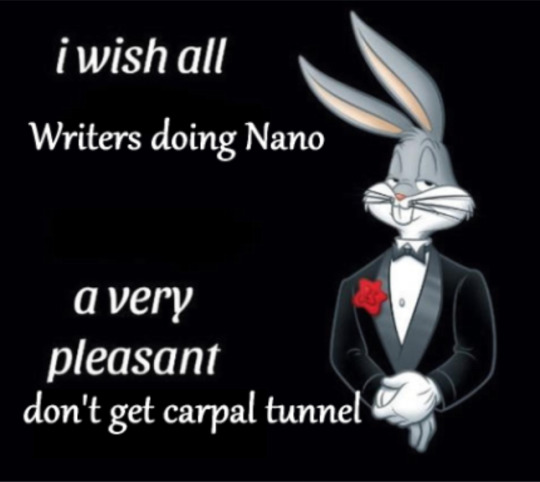
Take frequent breaks (drink water too!) and do your goddamn wrist stretches
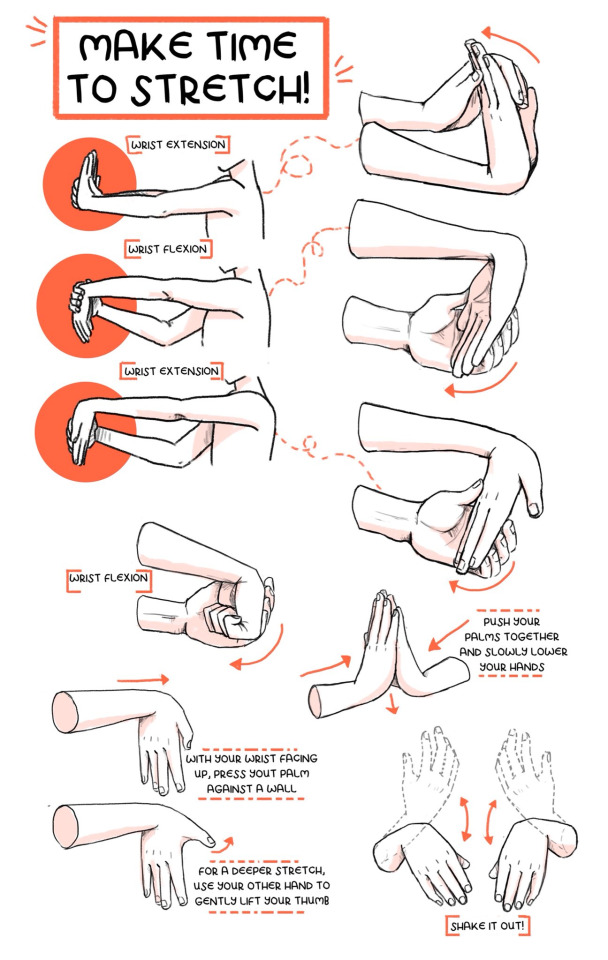
Image (source)
71K notes
·
View notes
Text
writing reminders
it's ok to write only for yourself
it's ok to not share your writing with the world
it's ok to want validation
it's ok to write self-indulgent stories
it's ok to write only one genre
it's ok to share your writing regardless of your skill
it's ok to praise your own writing
it's ok to abandon wips
it's ok if you don't write every day
it's ok if you write fanfiction (because people who claim it isn't real writing is wrong)
it's ok to use clichés
it's ok to have a bad day of writing
it's ok to be a slow writer
it's normal to have days in which you doubt the things you write, that doesn't mean you're a bad writer
it's ok to ask for feedback
it's ok to cringe at your old writing
it's ok to hype up your writing online
it's ok to celebrate your achievements
6K notes
·
View notes
Text
¡Buenas, gentes!
Mi nombre es M. Carmen, más conocida como Muffin Adorable en redes, y soy quien está detrás de la cuenta de reseñas literarias "Cafeína y letras".

Llevo mucho tiempo como usuaria de esta red social y creo que va siendo hora de que la página salga a ver mundo. Aquí daré eco de las reseñas que se suban a ella, además de dedicar en exclusiva a esta plataforma algunos artículos relacionados con las lecturas y el mundillo literario.
No dudeis en visitarla y permaneced atentos a las nuevas publicaciones.
Encantada de conoceros.
¡Un abrazo!
3 notes
·
View notes
Text
ways you can further develop your main character
give them a misbelief
no characters have a personality when the plot starts. all of them have backstories, a past, and a mindset that they grew up with!
basically, a misbelief is the wrong mindset that they grew up with, and is also a belief that will be restructured by the end of your novel.
this not only shows character growth and development as their mind is "restructured" or they learn their life lesson, but also drives the internal plot of your story, which differs from the external (or action) plot that most people seem to read.
+ this gives readers a deeper insight to your character!
give them a goal
every character has a goal, or something they want in their lives. having them strive for it would essentially drive your plot, and may also help you dig deeper into your character's motivations!
this goal doesn't always need to be achieved, or may be impossible to (for example, someone wanting to meet a loved one who turns out to be dead; they may have not reached their goal, but it took them on a journey)
this goal should also be concrete if possible! vague ones like "they want to be happy," isn't very helpful. what do they think will make them happy?
(side note: wanting everything to be the way that it is can also be a goal, cause they're striving to make things go back to the way they were!)
more notes / explanations here! most of these notes in this post are taken from story genius by lisa cron, and i thought they might help. please take all this information with a grain of salt, and maybe use it in a way that'll work best for you! <3
7K notes
·
View notes
Photo
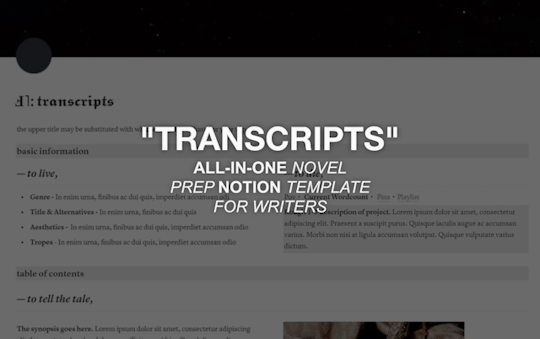
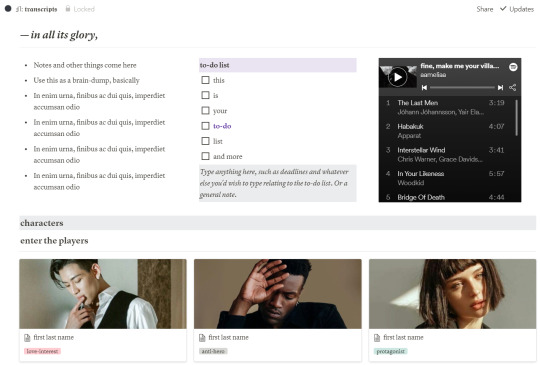
ALL-IN-ONE NOTION: “TRANSCRIPTS”
a highly customizable, simplistic but fancy notion template for writers. perfect for organizing notes while keeping it aesthetically-pleasing to look at. guaranteed higher muse and motivation to finish works-in-progress. to download / copy, click “duplicate” top-right to copy it to your notion.
features:
overview / introductory section (including a detailed synopsis section)
visual and simple overview of chapters
visual and simple overview of characters
note-taking section with a simple to-do list
tags system (e.g. completion status for chapters, character roles for characters)
locations section
in-depth notes section including a side dedicated for excerpts
please like / reblog if you’re using or interested in using it!
#notion#notion template#notion dashboard#organization#writing resources#rp resources#rp docs#novel prep#writing notes#spreads#.rp template#.notion is really saving me right now#.the aesthetic is beyond
4K notes
·
View notes
Text
NOTION TEMPLATE FOR WRITERS!

Hello! In this FREE Notion template for writers that I made, you can:
Manage your novels:

Have an overview of each novel:
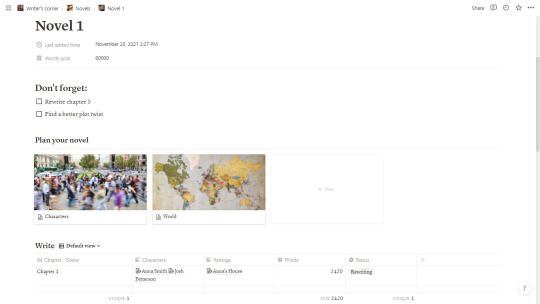
Create your characters:

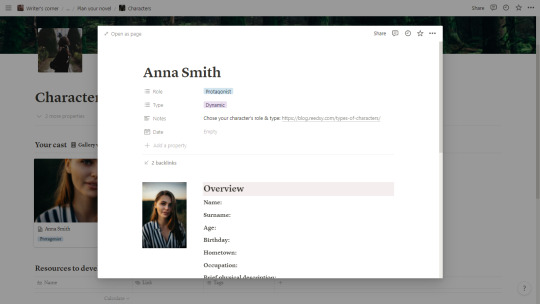
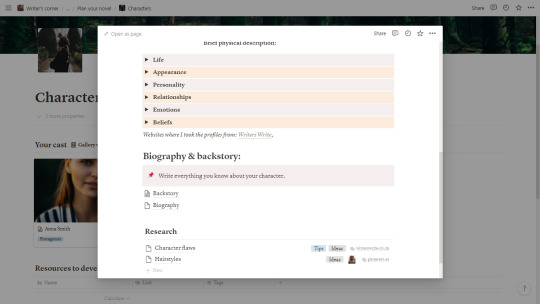
Build your world:


And then you ask...
Why should I use Notion?
Well, first of all, it is 100% FREE!
Plus, with my template, you have everything you need to start developing and writing your novel.
Also, Notion is totally customizable, which means that you are free to make the changes you need to adapt the template more to your liking.
TEMPLATE HERE! (Don't worry, this link is safe and will direct you to Notion.) To get the template, just click in "Duplicate":

I hope this was useful! Please consider checking out my blog and maybe subscribing to my newsletter! <3
#notion#writing#notion template#writeblr#aestethic#writing advice#writer tips#writing help#writing resources#poetsandwriters#writing tips#resources#software#website#writers#writerscommunity#writing reference#writblr#writersofinstagram#writerslife#novel writing#novel#authors#author#we love an useful post#free write#free resources#tips for writers#for writing
3K notes
·
View notes
Text
hurt comfort prompts
“ you can stay, if you'd like. “
“ please don't go. “
“ why don't we stay at your place tonight? “
“ can i get you anything? “
“ let's be pathetic together. “
“ are you crying? “
“ i'm glad you're here. “
“ you're not doing this alone. “
“ i don't have anyone anymore. “ “ you have me. “
“ are you sure [about staying]? “
“ you didn't force anything. i volunteered [to be here]. “
“ you are what’s important right now. “
“ do you need to vent? “
“ are you sure? it's quite heavy [of a topic]. “ “ i've got all night. “
'' tonight is about you. ''
'' you can make it up to me some other time. “
“ i've got nowhere else to be. “
“ you said you needed a distraction. “ “ so where is it? “ “ you're looking at it. “
“ why don't you come here for a second? “
“ wanna talk about it? “
“ i can't talk about it. not tonight. “
“ you need to distract me. do something, anything. “
“ i just don't want to be alone tonight. “
“ i'm tired of thinking. let's just... make out, or something “
“ i feel like shit. “ “ you look like it, too. “ “ hey! “
“ it’s okay to cry, you know. “
“ you’re a little hurt, that’s all. “
“ anything you want me to get you? “
“ nothing a good [drink] can't fix. “
“ let’s get you cleaned up. “
“ this is you thinking rationally? “
“ you're all i've got. “
'' c'mere. ''
'' let me give you a hug. ''
“ and you're absolutely sure this is what you need? “
“ you don't need this right now. “
“ how long will you stay? “ “ all night. if that's what it takes. “
“ what's it gonna take to make you smile? “
“ if you're not ready to talk about it, let's not. “
“ wanna play some mario kart? it'll give us both a reason to cry when you beat me. “
“ how about we stay like this, just, holding each other? “
“ i don’t know what’s wrong with me. “
“ i can’t stop crying. “
“ i'll be strong for the both of us. “
“ i didn’t know where else to go. “
“ the door's always open, you know that. “
“ i thought you were leaving town. “ “ well, i can't leave now. “
“ there's that smile i know and love. “
“ stay with me. “
“ hey, what’s your favorite snack? “
“ i’m not leaving. “
“ just let it out. “
“ you're stronger than you think. “
“ how about i make a quick run to the store, get you some aspirin? “
“ grab a burger or something on your way home. “
“ you were always there for me when i needed you. “
“ i didn't mean to bother you. “ “ you're not. “
“ hey, listen to me... “
“ you’re not a burden. “
“ aren’t you tired? “
“ this isn't about me. “
“ you’re going to be okay. “
“ hey, look at me… “
“ i don’t know what to do. “ “ we’ll figure it out. “
“ you’re not alone. “
“ hey, hey, hey, it's okay... it's okay. you're okay. “
#creative writing#writers#writing community#writeblr#writing#writing tips#writerblr#writers block#writing advice#writing prompts
9K notes
·
View notes
Text
My favorite forms of affection
Holding hands.
Resting their heads over my shoulder.
Lying on their lap or chest.
Kisses on the forehead.
Playing with my hair.
When they give me that look of admiration.
Them making me laugh.
Giving compliments.
Putting their arms around me.
Making me feel heard and seen without even trying.
Random hugs when words aren’t needed.
When they remember the things I am passionate about.
Buying me food.
Them checking on me constantly.
When they respect my boundaries.
When they talk to me about things that reminds them of me.
When they speak their truth.
When they say they love me.
When they lift me up, support me and make me feel valuable and capable when I least believe in it.
#writing tips#popular tags#dark acadamia aesthetic#aesthetic#dark academia#studyblr#creative writing#writing advice#writing prompt#love#romantic aesthetic#romantic quotes#wordsnquotes#beautiful words#novel excerpt#excerpts from my heart#excerpts from my writing#excerpt from a book i might write#poetry#booknerd#inspiring quotes#quotation#phrases#positiveenergy#dark academia tips#writers on tumblr#writers#free write#excerpt from a book i'll never write#inspirational words
16K notes
·
View notes
Text
writing tips: carl jung's character archetypes
the child / the innocent
- looks for happiness
- is afraid of being punished
- R2D2, Star Wars; Luna Lovegood, Harry Potter
the orphan
- looks to belong
- is afraid of exclusion
- Luke Skywalker, Star Wars
the hero
- looks to create change
- is afraid of being weak
- Katniss Everdeen, the Hunger Games
the caregiver
- looks to help others
- is afraid of their own selfishness (sometimes from a past selfish deed)
- Molly Weasley, Harry Potter
the explorer
- looks for freedom
- is afraid of entrapment
- Indiana Jones, Indiana Jones
the rebel
- looks for change
- afraid of being powerless
- Robin Hood, Robin Hood
the lover / the lovers
- looks for connection
- afraid of isolation
- Anna, Frozen; Belle and the Beast, Beauty and the Beast
the creator
- looks to realize their vision
- afraid of mediocrity
- Tony Stark, Iron Man
the jester
- looks for fun and amusement
- afraid of unfulfillment and boredom
- Mercutio, Romeo and Juliet
the sage
- looks for knowledge
- afraid of deception / "wrongness"
- Yoda, Star Wars
the magician
- looks to alter reality
- afraid of unintended results
- Dr. Strange, Doctor Strange
the ruler
- looks for prosperity
- afraid of being overthrown
- Darth Vader, Star Wars
#archetypes#writerblr#creative writing#writblr#lyralit#writers#writing ideas#writers block#writing#readerblr#writing prompts#12 archetypes#carl jung#writing prompt#writing community
1K notes
·
View notes
Text
Places To Post Original Fiction
1.) Commaful – a friendly and supportive writing community, smaller but denser than Wattpad, and far more active and engaging.
2.) FictionPress – original fiction’s answer to FanFiction.net. If you’re familiar with that format, you’ll be familiar with this.
3.) Smashwords – an ebook publishing platform that also welcomes short stories, and collections thereof.
4.) WritersCafe – old-school but solid, with an active community and plenty of contests/challenges to get the creative juices pumping.
5.) Medium – a place where you can post, essentially, anything and everything. Articles and non-fiction are its biggest market, but fiction is welcome as well.
6.) Booksie – less community-based, with fewer interactions and comments. However, it still attracts great talent, and can be great for authors who are shy and don’t want to get bombarded with interaction.
7.) RoyalRoad – a rich community, with a strong emphasis on mutual support between authors. Focuses on web novels, fanfiction, and original stories.
8.) FanStory – an oldie but a goody. Don’t be fooled by the name – it seems to be predominantly original fiction, and offers contests with cash prizes.
9.) Young Writers Society – as the name suggests, oriented towards writers in their teens and twenties, but is by no means exclusive to authors of this age bracket.
10.) Wattpad – Wattpad provides users with the opportunity to post original fiction and gain a loyal following. It’s not for everyone, but some people swear by it.
On that note, you can also post original fiction to AO3 and FanFiction, but as they are predominantly for fan works, I decided not to include them on this list. What’s your favorite way to post original fiction?
Happy writing, everybody!
4K notes
·
View notes
Text
Grand List of Writing Resources
I will link each category post here as I add more and I will continue to update it.
Outlining
Point of View
Character Development
Villains and Antagonists
Story/Character Arcs
Romance
Dialogue
Character Description (new)
...
#writingadvice365 resource list#writing help#writing advice#writing tip#writing resources#am writing#writers on tumblr#writers#writeblr#writing#on writing#masterpost
544 notes
·
View notes
Text
Character Description Writing Resources
Secrets to Writing Effective Character Descriptions
Character Descriptions: How to Write Them
How to Describe Skin Color
Describing Black Hair in Fantasy Settings
Importance of Small Details
@writingwithcolor Description Guide Posts
~~~
~Grand List of Writing Resources~
#writingadvice365 resource list#character description#character details#writing help#writing advice#writing tip#writing resources#writers on tumblr#writeblr#writers#writing#masterpost
2K notes
·
View notes
Text
fifty ways to get to know your characters (and how to write them)
what is their name? and how does this fit their character?
last name?
do they have a middle name?
name a song that describes them
what are their pronouns?
gender and sexuality?
do they like someone romantically?
list five words to describe them
what about five dialogue tags to use consistently on this character?
what is their motivation?
do they consider themselves a good person?
colour that describes their personality
MBTI type
enneagram type
character they're based on
person they would bring down whilst dying
person they would kill if they had the chance
character they would get along with if they were in the same universe
character they would hate if they were in the same universe
artist they would listen to
artist they would hate
give them a theme song
make them a playlist! (see my other post for songs to put on that playlist, here)
make them a mood board
assign them an aesthetic
what are their strengths?
what about fatal weaknesses?
the one person who can convince them to do something they're stubbornly against
who would they kill for?
what tropes do they fall into?
fatal weakness (food edition)
book they would definitely read
language besides their mother tongue they would (have) learned
murder accomplice
thing that makes them go weak at the knees
most obscure thing they HATE
while we're there, biggest phobia
are they (would they be) a book or movie person?
are they a romantic
childhood experience that defines an aspect of their life
what is their age?
birth sign? / zodiac?
what constellation would they be
name a famous myth could they would have been the main character
old or new soul
assign them a smell
assign them a smell they like
can they swim?
street smarts or brain smarts?
what is this character's purpose to the plot?
#writeblr#writing community#creative writing#writing ideas#writerblr#writblr#writers#writers block#writing#writing prompts#prompts#writing inspiration#story ideas#writing prompt#writing tips#character building#original character#oc
7K notes
·
View notes
Text
what to write next; wip writers' block edition:
switch POVs (this would differ if you really want it to be limited, but if you do switch, make sure to keep it [somewhat] consistent)
introduce a new character
scrap the planning and go off the rails (literally and figuratively)
kill off a character
turn something the characters have been chasing into something that doesn't exist
destroy the thing they've been chasing just when they get it
introduce another subplot
turn one of the mc's trusted characters into a traitor
what would you do to make your mc's life as difficult as possible? oh, that's evil. do it.
send the mc on a wild goose chase
make the mc screw up really, really badly
enact the Fatal Flaw™—make this make them screw up
the mc does something that splits up their group and renders them not trustworthy
the mc betrays their group
the characters are forced to sacrifice something dear
the villain dies
the villain is killed by an underling who is even worse than the original villain
introduce the person who controls the villain
kill off the mc's motivation
what would give the villain absolute power? a gateway to achieve their goal? do it, or if you can't, nudge them in the right direction
#writing ideas#writerblr#creative writing#writblr#writers#writing tips#writing#writers block#writing prompts#writing community#writeblr#writer inspo#writerscorner#wip#work in progress
2K notes
·
View notes